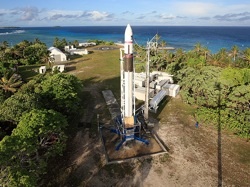October 1, 2008 - The Moon Society congratulates Space Exploration technologies for its successful launch to orbit of a payload aboard its Falcon 1 launch vehicle on September 28, 2008
Milestone Event
First
"privately funded", "ground-launched", and "liquid-fueled" launch
to orbit, the second two qualifiers in quotes excluding Orbital
Sciences' Pegasus and Taurus vehicles
Commenting
on this success, Space Frontier Foundation founder and visionary Rick
Tumlinson looks forward a few years to a possible Epoch as a Space-X
module docks with a Bigelow Aerospace station, as possibly the most
momentous single event in the history of The Space Age. Indeed such a
private enterprise achievement would signal that commercial space had
come of age.
Long range significance
There
is a range of opinion within the Moon Society, some believing strongly
that only US Government-NASA efforts can open the lunar frontier,
some believing that it has to be a multi-government, multi-agency
endeavor, some believing that the only effort that is going to lead to
settlement, not just "outposts and more exploration", is the private
enterprise route.
While that last option does involve a leap of faith, it is the one to which we personally subscriber, and surely, most of us who had previously joined the Artemis Society are of the same opinion. Thus I am inclined to echo Tumlinson's remarks.
While that last option does involve a leap of faith, it is the one to which we personally subscriber, and surely, most of us who had previously joined the Artemis Society are of the same opinion. Thus I am inclined to echo Tumlinson's remarks.
The announcement
HAWTHORNE, CA – September 28, 2008 – Space Exploration Technologies Corp. (SpaceX) Flight 4 of the Falcon 1 launch vehicle has successfully launched and achieved Earth orbit. With this key milestone, Falcon 1 becomes the first privately developed liquid fuel rocket to orbit the Earth.
Falcon 1 carried into orbit a payload mass simulator of
approximately 165 kg (364 lbs), designed and built by SpaceX, specifically
for this mission. Consisting of a hexagonal aluminum alloy chamber 1.5 meters
(5 feet) tall, the payload remains attached to the second stage as it orbits
Earth.
This module is pictured below just as the second stage engine quit firing, as orbit was achieved.
This module is pictured below just as the second stage engine quit firing, as orbit was achieved.

Below is a photo of the launch from Omaleek Island in the Kwajalin Atol, Marshall Islands, Pacific Ocean

The COTS Program
Space-X
is the surviving corporation of the first two firms to be awarded a
COTS (Commercial Orbital Transportation) Contract, the other being
RocketPlane Kistler which failed to meet funding goals. Andrews Space
was selected to replace RPK.
The COTS Program was created to support the emergence of a Commercially provided cargo and crew transport to the International Space Station in the interval between the retirement of the Space Shuttle, now extended past 2010, until the Constellation Orion module becomes flight ready.
Pictured below is Space-X' Dragon Cargo and Crew Modules being designed and built for ISS support.

The Moon Society strongly supports the COTS program and the development of commercial space capabilities in general. These are essential to the opening of a civilian frontier on the Moon.
The COTS Program was created to support the emergence of a Commercially provided cargo and crew transport to the International Space Station in the interval between the retirement of the Space Shuttle, now extended past 2010, until the Constellation Orion module becomes flight ready.
Pictured below is Space-X' Dragon Cargo and Crew Modules being designed and built for ISS support.

The Moon Society strongly supports the COTS program and the development of commercial space capabilities in general. These are essential to the opening of a civilian frontier on the Moon.


